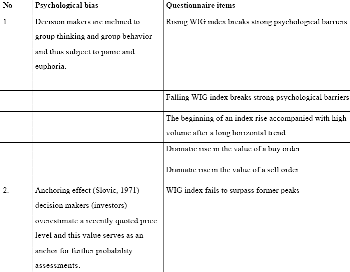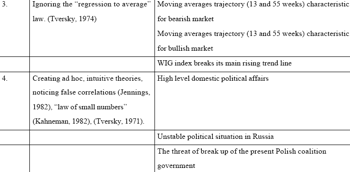I. The examined group of financial analysts distinguishes 4 factors (including economic, political and “technical” measures) on which stock prices depend:
- The growth of foreign and domestic investments in Polish stock market;
- The withdrawal of foreign and domestic investments from stock market;
- Unfavorable macroeconomic and political signals;
- Positive financial and macroeconomic signals.
Thus, their cognitive structure is not based on the nature of the signals, perceived as economic, political, or technical measures. The factors reflect two major mind constructs of questionnaire participants: macroeconomic conditions and the capital flow. The first construct reflects the state of Polish economy and the second one describes the will of Polish and foreign market participants to invest in Polish stocks.
II. As other research demonstrated (Cutler, 1989), there are a few economic measures, which had certain impact on stock prices behavior. However making the precise stock price predictions based on them seems to be too risky. On the other hand there are many measures which impact is completely “esoteric”. Evidently the questionnaire respondents do not make any distinguish between these two groups of measures.
Technical analysis persists in participants’ minds and its signals are treated equally to macroeconomic and political news in spite of the lack of any creditable evidence (Alexander, 1961), (Roberts, 1959) of its effectiveness. What more, as the cluster analysis demonstrated, the respondents give a strong predictive value to a great majority of items listed in the questionnaire. The second 10-item part of the questionnaire demonstrated that many technical analysis signals are generally appreciated by the participants and believed to have a predictive value.
III. The question arises as to why the well educated financial analysts regard so many unproven measures as being strong influences on stock prices. This can be explained by one of at laest three reasons:
a/. they were taught to take these items as such,
b/. they have a strong motivational impulse to believe it,
c/. they subject to some psychological inclinations.
ad a/. There are many financial handbooks listing without any empirical evidence a lot of signals allegedly determining future market movements. Some people including financial analysts take these statements for granted and believe them.
ad b/. According to the famous behavior-attitude relationship, discovered by Leon Festinger people strive to have their attitudes, beliefs and behaviors support one another. When these components come into conflict, a person becomes uncomfortable and experiences a state of cognitive dissonance. To relieve this dissonance, the person will try to change the cognitions so that they will again be in agreement. Financial analysts must have to strive to predict market movements and put a lost of effort in it. If they were convinced about the randomness of stock prices movements, they would hold two cognitions: (1) they work hard to predict X, and (2) the X is random. Because they cannot change the fact that they work hard, they can reduce their dissonance by changing their attitude about X. They can come to believe that X is predictable. (Worchel, 1995)
ad c/. Cognitive psychologist discovered dozens of psychological inclinations, which have big impact on human judgements. Some of them financial analysts seem to subject to. These inclinations are responsible for a long list of purely esoteric items chosen by questionnaire respondents as allegedly important in relation to future stock behavior. Particularly interesting is the phenomenon that almost all the esoteric measures received the very high absolute scores both in cluster “H” and “L”. This indicates how overwhelming those psychological inclinations could be. Table 2 presents the esoteric questionnaire items ascribed to the following psychological inclinations.
1/. Group thinking and group behavior. People often represent group thinking and behavior, overestimate views shared by others and thus subject to panic and euphoria.
2/. Anchoring effect (Slovic, 1971) Decision makers (investors) overestimate a recently quoted price level and this value serves as an anchor for further probability assessments.
3/. Creating ad hoc, intuitive theories, noticing false correlations (Jennings, 1982),
4/. “Law of small numbers” (Kahneman, 1982), (Tversky, 1971). People exaggerate how closely a small sample will resemble the parent population from which a sample is drawn. When the underlying probability distribution generating observed sequences is uncertain, the law of small numbers will lead people to over-infer the probability distribution from short sequences. This tendency to over-infer from short sequences leads in turn to misperception of regression to mean.
5/. Ignoring the “regression to average” law. (Tversky, 1974) Misunderstanding regression to mean gives rise to some spurious explanations for observed regression. One of the implications of this inclination is that people expect too few lengthy streaks in sequences of random events, they tend to generate spurious explanations for long streaks that are determined by chance. (Rabin, 1998)


Table 2. A list of psychological biases and the questionnaire measures referring to them.
There is no proof that the questionnaire items listed in the Table 2 have any predictive meaning. The respondents marked them as having such. Why? Besides the conitive dissonance phenomenon, whose impact is able to explain this bahavior, in the case of the items listed above additional effect can play a role: psychological inclinations and rules of thumb.
One cannot conclude that the questionnaire items such as: “Increase in the dynamics of privatisation” or “Industrial production decline” say something about the psychology of the market. On the contrary, the items like: “WIG index fails to surpass former peaks”, “Moving averages trajectory (13 and 55 weeks) characteristic for bearish market” or “WIG index breaks its main rising trend line“ seem to represent certain common psychological biases. Fischer Black noticed that the noise is a major reason for the use of rules of thumb.
“Even highly trained people seem to make certain kinds of errors consistently. There is a strong tendency in looking at data to assume that when two events frequently happen together, one causes the other. There is even stronger tendency to assume that the one that occurs first causes the one that occurs second. These tendencies are easy to resist in the simplest cases. But they seem to creep back in when econometrics studies become more complex.” (Black, 1986)
As research done by Kahneman and Tversky (1982) shows, even experience, expertise and learning do not virtually eliminate psychological biases. The biases may appear as well in the behavior of highly trained professionals.
IV. There are many economic, political or technical signals occurring simultaneously. In spite that the analysts are almost unanimous about how a certain event affects the market, they are not unanimous about which of the item is crucial at the moment. This causes the randomness of stock prices movements. On the other hand the unanimity among investors in treating a particular event as a valid signal of future stock price changes simultaneously may lead to a self-fulfilling prophecy on the market. The self-fulfilling prophecy might be evoked not only by a strong common opinion on validity of some fundamental news but also by a common belief in a strong predictive power of esoteric measures.
Prof. Piotr Zielonka
Next: References
Summary: Index